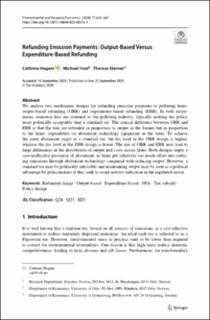| dc.contributor.author | Hagem, Cathrine | |
| dc.contributor.author | Hoel, Michael | |
| dc.contributor.author | Sterner, Thomas | |
| dc.date.accessioned | 2021-03-16T09:49:36Z | |
| dc.date.available | 2021-03-16T09:49:36Z | |
| dc.date.created | 2020-10-14T14:33:36Z | |
| dc.date.issued | 2020 | |
| dc.identifier.citation | Environmental and Resource Economics. 2020, 77 1-27. | en_US |
| dc.identifier.issn | 0924-6460 | |
| dc.identifier.uri | https://hdl.handle.net/11250/2733563 | |
| dc.description.abstract | We analyse two mechanism designs for refunding emission payments to polluting firms: output-based refunding (OBR) and expenditure-based refunding (EBR). In both instruments, emission fees are returned to the polluting industry, typically making the policy more politically acceptable than a standard tax. The crucial difference between OBR and EBR is that the fees are refunded in proportion to output in the former but in proportion to the firms’ expenditure on abatement technology equipment in the latter. To achieve the same abatement target as a standard tax, the fee level in the OBR design is higher, whereas the fee level in the EBR design is lower. The use of OBR and EBR may lead to large differences in the distribution of output and costs across firms. Both designs imply a cost-ineffective provision of abatement, as firms put relatively too much effort into reducing emissions through abatement technology compared with reducing output. However, a standard tax may be politically infeasible and maintaining output may be seen as a political advantage by policymakers if they seek to avoid activity reduction in the regulated sector. | en_US |
| dc.language.iso | eng | en_US |
| dc.publisher | Springer Nature. | en_US |
| dc.rights | Navngivelse-Ikkekommersiell-DelPåSammeVilkår 4.0 Internasjonal | * |
| dc.rights.uri | http://creativecommons.org/licenses/by-nc-sa/4.0/deed.no | * |
| dc.title | Refunding emission payments: Output-based versus expenditure-based refunding | en_US |
| dc.type | Peer reviewed | en_US |
| dc.type | Journal article | en_US |
| dc.description.version | publishedVersion | en_US |
| dc.rights.holder | © The Author(s) 2020 | en_US |
| dc.subject.nsi | VDP::Samfunnsvitenskap: 200::Økonomi: 210 | en_US |
| dc.source.pagenumber | 641–667 | en_US |
| dc.source.volume | 77 | en_US |
| dc.source.journal | Environmental and Resource Economics | en_US |
| dc.identifier.doi | 10.1007/s10640-020-00513-1 | |
| dc.identifier.cristin | 1839589 | |
| dc.relation.project | Norges forskningsråd: 295789 | en_US |
| dc.relation.project | Norges forskningsråd: 209698 | en_US |
| cristin.ispublished | true | |
| cristin.fulltext | original | |
| cristin.qualitycode | 1 | |

